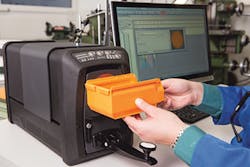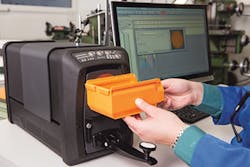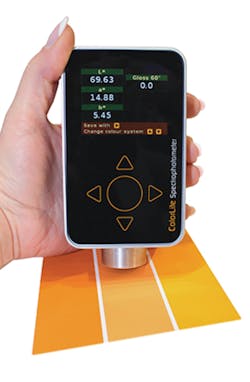Special Report: Color analysis gains in sophistication
Sophisticated tools and computer analysis are increasingly replacing the human eye as demand grows for more precise and repeatable color analysis of plastic products.
"Color tolerances are tighter today than they were 15 or 20 years ago," said Mike Beering, industrial color and appearance product manager at X-Rite Pantone, Grand Rapids, Mich. "For the brand owner, color is a critical part of its brand identity, and color is often a deciding factor in a customer's purchasing decision."
Suppliers of color-measurement equipment emphasize that the high costs of scrapping reject parts — and the customer dissatisfaction that results — can be avoided with the purchase of instruments that typically cost $8,000 to $25,000.
"With the more information you get about color, you can really improve your process and reduce your scrap rate," said Paul Barnes, sales manager at Hunter Associates Laboratory Inc. (HunterLab), Reston, Va.
Maintaining proper color can be demanding. With supply chains stretching around the globe, manufacturers must deal with variations in environmental standards and materials that can affect color. The increased use of specialized pigments, such as thermochromatics and metallic flake compounds, also creates challenges.
In an effort to monitor and maintain quality, suppliers are responding with more advanced systems and tools — both lab-based and in-line for continuous processes such as the extrusion of vinyl siding.
Devices show how reflection,color measure up
To make color-evaluation equipment more cost-effective, suppliers offer devices that can combine functions.
One example is the X-Rite Ci7800 bench-top spectrophotometer, which offers both reflectance and transmission measurements that are not available on colorimeters. "This is especially important for plastics, because not all plastics are opaque," said Beering.
Datacolor's new 850 and 550 spectrophotometers provide reflectance and transmission measurement digitally throughout a supply chain. The 850 includes a built-in digital camera for sample placement and is compatible with prior generations of instruments from Datacolor, Lawrenceville, N.J. The Datacolor 850 and 550 have color LCD screens that display instrument settings and calibration status. The instruments have embedded processors and include an Ethernet port.
"With the embedded processor and advanced algorithms, users see at least a 25 percent reduction in measurement time and a quantifiable improvement in throughput," said Diane Geisler, Datacolor global director of product management.
Another example is the Vista spectrophotometer, which HunterLab introduced in May at the Analytica trade show in Munich. The instrument can capture both visible transmission color and haze simultaneously. It has a small footprint and includes electronic calibration and a spill-resistant sample compartment for improved accuracy, longevity and flexibility. "Typically customers are reading color and haze with two instruments," said Ken Phillips, market development manager at HunterLab.
Other color-evaluation devices include the CM-5 spectrophotometer from Konica Minolta Sensing Americas Inc., Ramsey, N.J. It's a bench-top instrument designed to evaluate the color and appearance of opaque, transparent and translucent samples. The CM-5 is compatible with SpectraMagic NX software to record measurements and provide a more comprehensive color analysis, as well as Colibri software to formulate color recipes for various applications.
The BYK-mac i spectrophotometer from BYK Gardner USA, Columbia, Md., specifically targets metallic colors. It measures multi-angle color as well as sparkle and graininess and also can detect and quantify fluorescent light in the visible range. One version can be mounted on a robot, ensuring measurement of the same area after each mold cycle.
X-Rite also offers a tool called the NetProfiler to assure that spectrophotometers are working properly and delivering accurate measurements. "It also enables the standardization of color-acceptance criteria and quality across locations and at every step of the production process," said Beering.
Monitoring color in-line
The biggest market for color-measuring equipment for plastics is in quality-control labs. Now there's growing interest in continuous color measurement for extruders.
David Pryor, owner of ColorLite GmbH, Katlenburg-Lindau, Germany, said, "For the plastics industry, in particular, we see more and more companies looking for in-line measuring systems. We can measure plastics sheet in a reflectance or transmission mode, with systems that can be connected to the dosing unit. We also measure plastic granules in the production line."
Increasingly, HunterLab's Barnes said, suppliers are responding to demand for real-time information that allows manufactures to take corrective action immediately. As an example, he cited the challenges of producing vinyl siding. "A builder is not going to stop building a house if they get a box of material that is off-color. After an inspection, there will have to be a redo. So every time that happens, there's a $20,000 cost to a vinyl siding manufacturer. That's enough to pay for an online instrument that would stop outgoing defective material."
HunterLab and Plastore Inc., Hudson, Ohio, developed Color Process Automation Technology (cPAT), which continuously monitors color and makes the necessary feeder changes at the correct times to maintain constant color. Most extruders perform color checks at 30-minute intervals, said Phillips of HunterLab.
Color readings are made by the Spectra Trend HT, a high-resolution, lab-grade spectrophotometer designed specifically for in-line color monitoring. It can be placed before or after the extrusion system's cooling tank. Plastore makes additive feeders for extruders, injection molding and blow molding machines.
Barnes estimated that only about 15 percent of extruders use in-line color-measuring equipment. The need to maintain control over color is growing as the number of color changes goes up. Extruders are increasingly producing on demand, with some processors changing color 10 times per day per line.
X-Rite eXact Xp was introduced recently to help converters more accurately measure color on flexible film substrates. For some types of films, the orientation of the measurement instrument relative to the film's extrusion direction can impact results.
"The costs of getting color wrong on packaging can be significant," said Chris Winczewski, VP of product marketing, X-Rite Inc. "With X-Rite eXact Xp for measurement, PantoneLIVE as a repository of reliable digital color standards and ColorCert X-Rite Edition for statistical process control, packaging converters can deliver new levels of color control and increased service."
Software providessmarter options
The newest products in the color-measurement field increasingly use embedded software that mimics the usability of smartphones and tablets. "Increasingly, our target audience is millennials who are used to getting information at the touch of a finger," said Phillips. "Our latest product uses tablet-based, smart technology embedded in the instrument that operates on Wi-Fi, Bluetooth, Ethernet, USB — all the things that millennials are accustomed to." Color-measurement data can be sent from the plant floor to a manager's smartphone or iPad at home at any time. Users define the format based on their company's plantwide data-distribution system.
The new ColorLite xs1 spectrophotometer is hand-held and has the look of a smartphone. It has Internet connectivity and the same resolution as a bench-top spectrophotometer, the company said.
Doug Smock, senior correspondent
Contact:
BYK Gardner USA, 301-483-6500, www.byk.com
ColorLite GmbH, +49-5552-999-580, www.colorlite.de/en
Datacolor, 609-924-2189, www.datacolor.com
Hunter Associates Laboratory Inc., 703-471-6870, www.hunterlab.com
Konica Minolta Sensing Americas Inc., 201-236-4300, http://sensing.konicaminolta.us
Plastore Inc., 330-653-3047, www.plastore.com
X-Rite Pantone, 616-803-2100, www.xrite.com



